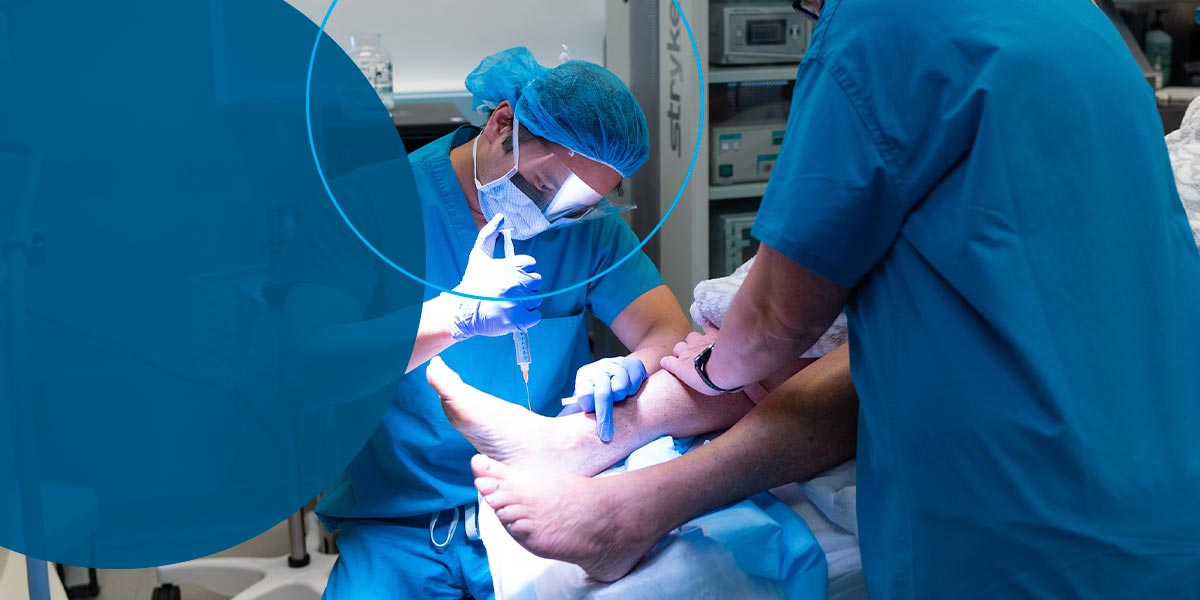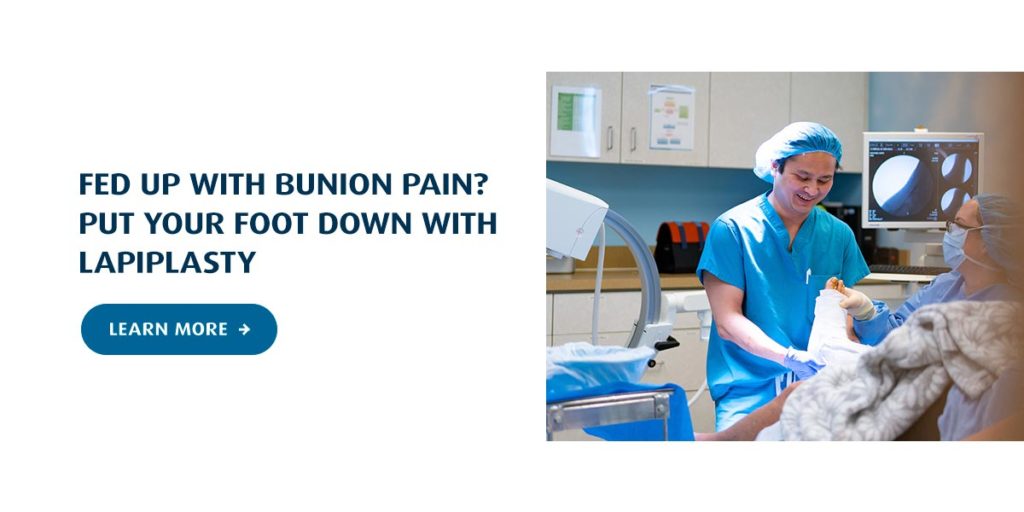BENEFITS OF LAPIPLASTY
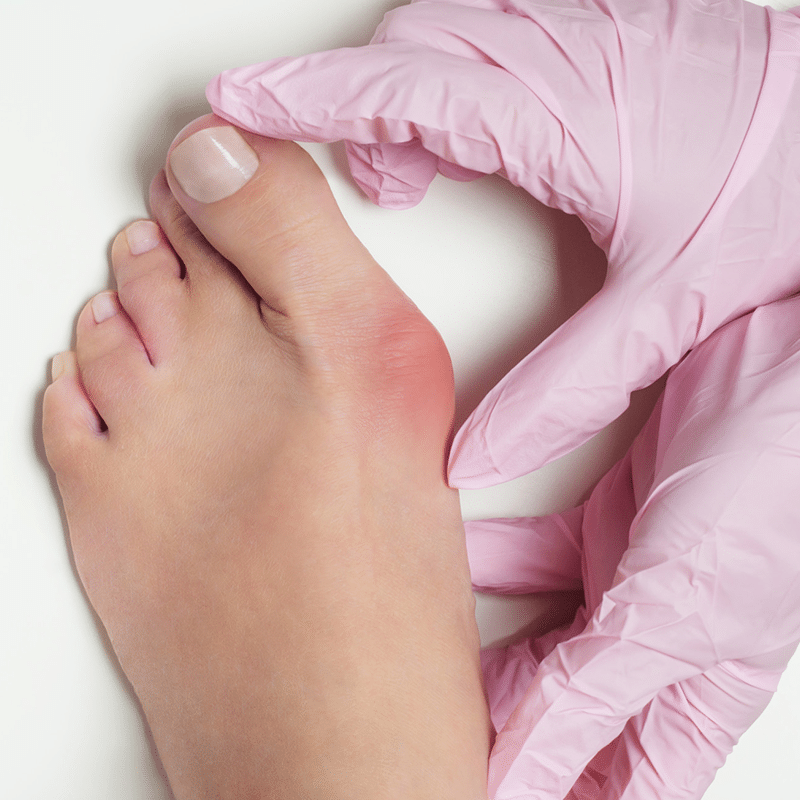
Bunions are among the most common orthopedic issues affecting the feet. Studies show that approximately one-third of Americans suffer from bunions.
Among specific populations, this number rises dramatically. According to the American Orthopaedic Foot and Ankle Society (AOFAS), as many as 55% of older women have bunions.
Importantly, however, bunions can affect anyone at any age.
If you are among those suffering from bunions, it’s in your best interest to seek relief. Finding relief requires learning about your condition and possible treatments.
Lapiplasty is among the most promising new treatments for bunions. Read on to learn more about the benefits of lapiplasty compared to other bunion treatments.
What Are Bunions?
Bunions are bony protrusions, or bumps, that appear on the outside of the big toe. A common misconception is that an overgrowth of bone causes this protrusion. Some surgical bunion treatments involve removing part of the bone based on this misconception. Unfortunately, these treatments do not address the underlying problem with bunions.
In fact, bunions do not represent an overgrowth of bone. Rather, they indicate a deformity of the foot’s anatomical structure. In almost all bunion cases, this deformity is complex and occurs in three dimensions. In other words, bunions involve three shifts in the first metatarsal bone.
Your foot has five metatarsal bones — one for each toe. The metatarsals connect your toes to the rest of your foot. The first metatarsal lies between the big toe’s phalanges and the mid-foot tarsals. Your phalanges are the bones inside your toes, while your tarsals connect your metatarsal bones to your heel and ankle joint. When the joint between the first tarsal and metatarsal becomes unstable, the first metatarsal can shift in three directions.
With the first shift, the metatarsal begins to lean sideways. Second, the metatarsal lifts, transferring an excessive load to the other toes. In the final shift, the metatarsal bone rotates out of alignment, causing abnormal wear.
The most effective bunion treatments, like lapiplasty bunion surgery, address this complex, three-dimensional deformity.
What Are the Symptoms of Bunions?
The most obvious symptom of a bunion is a bulge at the base of the big toe. Some bunions produce this visible deformity and no additional symptoms. Over time, however, many bunions begin to cause discomfort.
Additional symptoms of bunions include:
- Soreness around the big toe joint
- Swelling or redness around the joint
- A limited range of motion in the big toe joint
- Corns and calluses between the first and second toes
Bunion pain, redness and swelling can be constant or sporadic. You might notice that certain factors increase irritation. Wearing ill-fitting shoes can contribute to the formation of bunions or aggravate existing bunions. Overuse can further irritate a bunion.
If you notice any of the above symptoms, it’s important to seek medical advice. An experienced podiatrist will conduct a physical exam and X-Ray to evaluate your foot’s anatomy. Based on these findings, your doctor can recommend an effective treatment.
Bunions can lead to additional complications if they’re left untreated. These complications include bursitis, arthritis, hammertoe and metatarsalgia. Scheduling routine preventative visits and seeking prompt treatment when issues arise are important steps to take to protect yourself from these painful conditions.
How Are Bunions Treated?
Bunion treatments include conservative options and surgical treatment. Discuss your options with your doctor before deciding on a treatment plan.
Conservative Treatments
Conservative, nonsurgical treatments focus on relieving symptoms and preventing further misalignment. These measures include:
- Wearing comfortable shoes that offer adequate space for your toes
- Using nonmedicated pads to cushion the painful joint
- Using over-the-counter pain relievers and anti-inflammatories, like acetaminophen, ibuprofen or naproxen sodium
- Getting a cortisone shot to reduce inflammation
- Using over-the-counter or prescription shoe inserts to relieve pressure on the joint, also known as orthotics
- Using a bunion splint, sleeve or toe spacers to temporarily improve the joint's alignment
- Icing your bunion to relieve inflammation, swelling and pain
Hoping to avoid surgery, many patients try these conservative methods first. Some patients find that they can, for a time, manage their discomfort using nonsurgical treatments.
Still, even conservative treatments present disadvantages. First, the long-term use of anti-inflammatories is associated with serious health risks. These risks increase in older adults and include:
- Stroke
- Myocardial infarction, which occurs when your heart doesn’t receive enough oxygen
- Gastrointestinal complications, such as heartburn or peptic ulcers
- Acute or chronic kidney failure
- Nephrotic syndrome
- Worsened hypertension, or high blood pressure
Cortisone injections can offer longer-lasting relief from inflammation and pain. However, they also involve risks, such as:
- Osteoporosis
- Diabetes
- High blood sugar
- Glaucoma and cataracts
- Immunosuppression
- Cardiovascular disease
- Gastrointestinal complications
These adverse risks increase with frequent use. To reduce these risks, experts recommend limiting cortisone injections to no more than 3-4 times per year.
Even icing a bunion can involve risks for certain patients. For example, some patients with circulation problems should consult a doctor before beginning an icing regimen.
Other patients put their hopes in bunion splints, sleeves, toe spacers and other orthotic devices. These devices may appear to improve the alignment of the affected joint. They may also provide some pain relief when walking or performing other activities.
However, bunion splints cannot “cure” or “correct” a bunion. Any improvement or relief is temporary, lasting only as long as the patient wears the device.
In fact, the biggest drawback of all conservative treatments is that none address the cause of the problem. Bunions involve a three-dimensional misalignment of the bones and joints, and only certain surgical treatments can correct this complex misalignment. Two of these surgical treatments include osteotomy and lapiplasty.
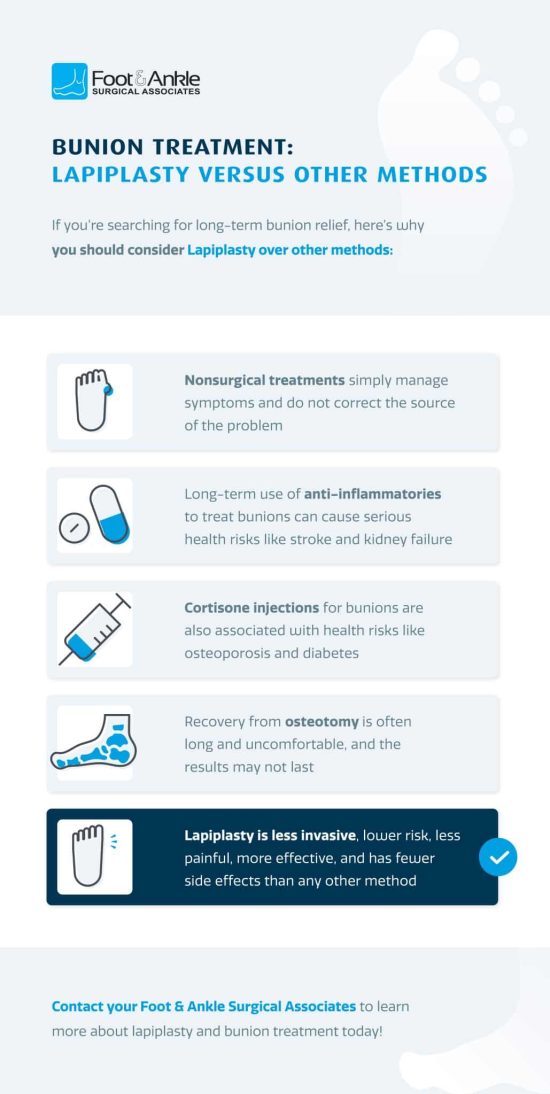
What is Osteotomy?
Among the most common surgical bunion treatments is an osteotomy.
An osteotomy involves shaving or cutting the part of the bone that protrudes from your foot. It can also involve cutting the first phalange or metatarsal to shorten and realign the bones. Pins are used to hold the newly segmented bones in place. To further realign the foot, tight tendons and ligaments are released. Meanwhile, loose tendons and ligaments are tightened.
Following an osteotomy, the patient’s foot is placed in a cast for 3-6 weeks. Some procedures require patients to avoid bearing weight on the affected foot for 6-8 weeks.
Of course, full recovery times vary depending on the extent of the realignment required. However, the average recovery from traditional bunion surgery can take up to six months.
Still, some patients find that their recovery takes a year or more. Others find that they never recover fully. In fact, a third of patients are dissatisfied with the results of traditional bunion surgery.
- Recurrence of the bunion
- Arthritis
- Avascular necrosis, or death of the bone caused by a disruption in blood supply
- Nerve damage that results in limited or uncomfortable sensations in the feet
- Stiffness and a limited range of movement in the affected toe
- Ongoing pain and swelling
The most complications are ongoing pain, swelling and stiffness. Recurrence of the bunion is also common, as traditional bunion surgery fails to address the root cause of the problem.
In fact, traditional bunion surgery takes a two-dimensional approach to a three-dimensional problem. A newer technique—lapiplasty—takes a more effective three-dimensional approach.
NeW Bunion ProCEDure - LAPIPLASTY
Lapiplasty is less invasive, lower risk, less painful, and more effective than an osteotomy. Keep reading to learn more!
What is Lapiplasty?
Many people wonder, what is a lapiplasty? Lapiplasty is a less invasive bunion treatment method that corrects the root cause of the bunion. In other words, it addresses the misalignment in all three dimensions. Moreover, lapiplasty achieves these corrections in a less invasive manner than traditional bunion surgery.
How does Lapiplasty work?
Unlike an osteotomy, lapiplasty does not involve cutting or shaving the bones. Instead, it uses advanced instruments to push the entire metatarsal bone back into place. With the proper alignment achieved, lapiplasty uses innovative titanium plate technology to secure the bones.
In this way, lapiplasty naturally and permanently corrects the protrusion and straightens the toe. It also protects patients from the above complications, produces greater patient satisfaction, and significantly reduces recovery time.
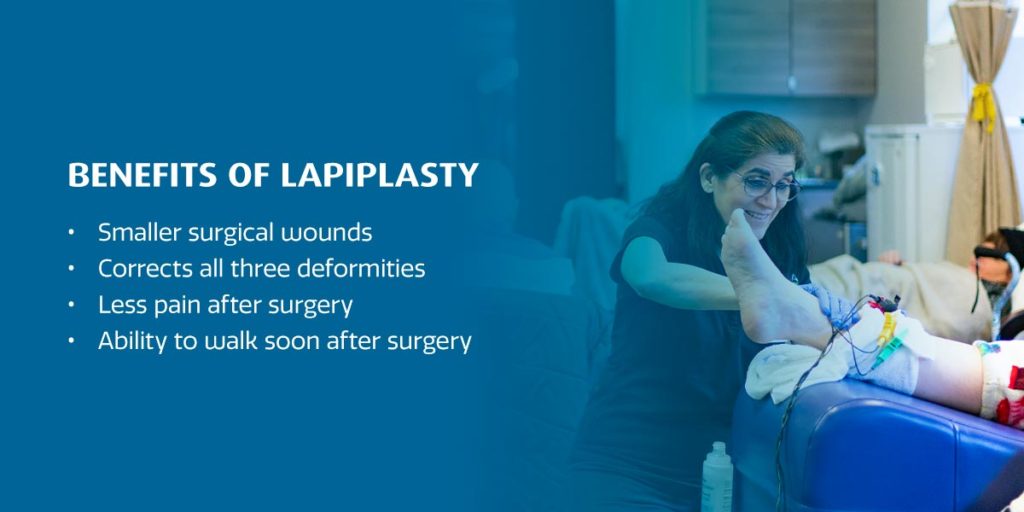
Karla's story:
"You can't just still especially on a sunny day."
BENEFITS OF LAPIPLASTY
Lapiplasty is a less invasive alternative to traditional bunion surgey that is more effective at correcting each misalignment issue with bunions. Here are some of the benefits of lapiplasty when compared with osteotomy and other bunion treatments:
- Smaller surgical wounds: Lapiplasty incisions are smaller than those with traditional osteotomy, which is open surgery. The smaller incisions are beneficial in several ways. First, they present fewer risks of surgical site infections (SSIs). Since less of the foot is exposed to the open air and surgical instruments, there is less risk of infection. Second, the recovery period for lapiplasty is shorter since less of the foot has to heal from the procedure. Finally, there will be smaller scars at the surgical site — most of the time, lapiplasty scars are scarcely visible.
- Corrects all three deformities: Since lapiplasty corrects all three shifts in the metatarsal bone that lead to bunions, it is much more effective at treating them than osteotomy or any nonsurgical bunion treatment. This way, lapiplasty restores your foot and the big toe to their normal alignment.
- Less pain after surgery: Since lapiplasty has smaller incisions and doesn’t involve shaving or cutting away the bone, it typically has less post-surgical pain. With less post-surgical pain, you won’t need to rely on pain relieving medication as much during your recovery time. Further, your recovery period with lapiplasty will be much more manageable and less restrictive than recovery from traditional osteotomy.
- Ability to walk soon after surgery: Most lapiplasty patients can walk soon after surgery after they are fitted for a walking boot. Some can bear weight on their foot immediately after surgery, while others come back in a couple of days to be fitted for a walking boot.
SHOULD I GET A LAPIPLASTY?
If you’re dealing with significant bunion pain and conservative treatments have failed to bring relief, you’re an ideal candidate for Lapiplasty 3D Bunion Correction treatment. Or, you may only have visible symptoms of bunions without the pain and discomfort. In these cases, discuss with your doctor whether you should try conservative treatments or get lapiplasty to correct the problem at its root.
Frequently Asked Lapiplasty Questions
Patients who choose lapiplasty report better results and quicker recoveries. Still, lapiplasty is a surgical procedure. Choosing to undergo any surgical procedure is a weighty decision.
Knowing what to expect can help you make the best decision for you. It can also reduce any anxiety you might feel as the procedure approaches.
Lapiplasty is an outpatient surgery.
The procedure usually takes about an hour. After monitoring your recovery, your surgery team will advise you on at-home care before discharging you the same day.
No. After surgery, your doctor will wrap your foot in bandages to protect the incision. You can expect to leave these bandages in place for a few days. After that time, you’ll switch to a surgical walking boot.
Most lapiplasty patients are able to bear weight on their foot within a few days of the procedure. In fact, some patients can bear weight immediately after surgery. Of course, everyone’s recovery is different. However, almost all patients can bear weight within 2-3 weeks after surgery.
Yes! Lapiplasty patients experience no permanent limitations on their activities or activity levels.
Always follow your doctor’s advice as you return to your pre-surgery routines. Still, you can anticipate a return to sports within four months of your procedure.
Again, the answer is yes. Patients who have undergone lapiplasty can wear the same shoes as those with normal feet.
Of course, it’s important to remember that some shoes are uncomfortable even for healthy feet. Furthermore, certain shoes can contribute to foot deformities, including bunions. So it’s always important to choose your footwear carefully. However, the lapiplasty procedure itself imposes no limitations.
Fed Up with Bunion Pain? Put Your Foot Down with Lapiplasty
Bunions affect millions of Americans. If you’re among them, you don’t have to continue suffering.
Lapiplasty offers a promising surgical treatment option. It involves a less invasive procedure, fewer complications, and a quicker recovery than traditional bunion surgery. It also addresses bunions at their root cause.
Contact your Foot & Ankle Surgical Associates to learn more about lapiplasty and bunion treatment today by calling us at (360) 754-3338. Schedule an in-office visit with one of our experienced podiatrists. Or, if you prefer, we also offer telehealth “house calls.”

